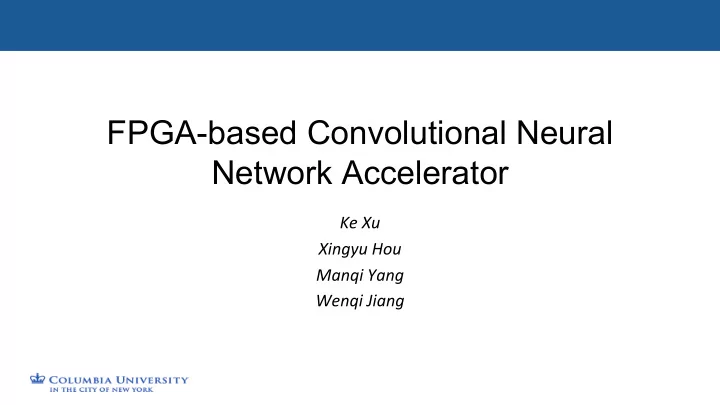

FPGA-based Convolutional Neural Network Accelerator Ke Xu Xingyu Hou Manqi Yang Wenqi Jiang
Outline • Background • Software Implementation • Python / C implementation of VGG-16 • Profiling and acceleration strategy • Dynamic fixed point conversion / operation • Hardware Implementation • SDRAM and DMA • Dataflow design • PE implementation • Conclusion
Background • Convolutional Neural Networks ( CNN) • Computer Vision - Image Classification, Object Detection, Semantic Segmentation • Mainly composed of convolutions and matrix multiplications • Both these computations are highly parallelizable • Dedicated Hardware • CPU: latency oriented; not good at massively parallel computations • FPGA: by using many Processing Elements (PE), FPGA can compute many output elements in parallel
VGG16
Software Simulation • For reference, download a Keras-based VGG16 implementation and weights of the model • Reproduce the VGG16 model using Python, including convolution layers, fully-connected layers, pooling layers and activation functions • Compare the result with the Keras model to verify the correctness • Port the python implementation to C for later use
Software Simulation Part of our python and C implementations
Algorithm Optimization - Winograd • Winograd • Memory consuming (need extra space to store intermediate results) • Reduce 1/3 multiplications when using our dataflow pattern, while consumes about 2x of memory usage Figure above shows the Winograd process: • Directly convolution: 4 * 3 * 3 = 36 multiplications • Winograd convolution: 4 * 4 = 16 multiplications • 2.25x speed up
Software Profiling • Implement the software profiling in C to see which parts should we accelerate on FPGA • Neglect max pooling, ReLU and softmax function, since the time they consume is negligible • Time consumed comparison between convolution layer and fully- connected layer using i5-8259U (without loading weights and data) Convolution Layers Fully-connected Layers Time Consumed / sec 92.02 4.15 Time Percentage / % 95.67 4.32
Software Profiling • Time complexity analysis • Convolutional layer: O(conv_height * conv_width * conv_channel * conv_number * input_width * input_height) e.g. 3 x 3 x 256 x 512 x 28 x 28 = 924,844,032 • Fully-connected layer: O(fc_height * fc_width) e.g. 4,096 x 4,096 = 16,777,216 • Convolutional layer > fully-connected layer
Software Profiling • Memory consuming analysis • Convolutional layer: O(conv_height * conv_width * conv_channel * conv_number) e.g. 3 x 3 x 256 x 512 = 1,179,648 • Fully-connected layer: O(fc_height * fc_width) e.g. 4,096 x 4,096 = 16,777,216 • Convolutional layer < fully-connected layer
Software Profiling • Computation intensive VS memory access intensive Convolution Layers Fully-connected Layers Ratio (conv / fc) Weights number 14,710,464 123,633,664 0.12x Multiplications number 16,271,474,688 123,633,664 131.61x • Accelerator strategy • Compute convolutional layers on FPGA • Compute fully-connected layers using CPU • If we compute both these layers on FPGA • allocate some FPGA resources, e.g. DSPs, to fully-connected layers, which will slow down convolutions • copy weights (>200M bytes) from DRAM to SDRAM, which is time- consuming (>30s)
Fixed Point Computation • FPGA is good at fixed point operations, so we use fixed point instead of floating point to do convolutions • Challenge: • Weights, input image and intermediate results have different ranges • Can not use a unified decimal point place, e.g. in the middle of a fixed point:1100.0011
Fixed Point Computation • Solution: dynamic fixed point • 1100.0011 VS 10.101100 • length allocate to integer and decimal part differs from layer to layer • use 1000 samples to measure the intermediate output ranges of each layer • can be decided before runtime
Fixed Point Computation • Conversion • Convert images and weights to dynamic fixed point numbers • Save these numbers and feed them into our C program • Simulation • Dynamic fixed point operations • Inputs and outputs can have different decimal point place • e.g. 0011.1010 x 011.00000 = 01010.111 (3.625 x 3 = 10.875) • Simulate fixed point operations on hardware • Helpful when debugging hardware functions
Fixed Point Computation • Build tools for fixed point conversions and verification • Some of the functions we build • Conversion float2fixed, fixed2float • Dynamic fixed point operations fixed_add, fixed_mul, fixed_shift, inverse, ReLU, etc. • Other functions digit_of // how many digits should we assign to integer and decimal parts
Software Summary
Hardware System Structure
Data Alignment in SDRAM
Dataflow Design
Q & A
Recommend
More recommend